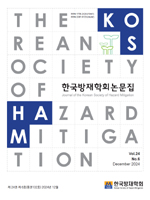노모그래프 기반 지하굴착공사현장의 실시간 침수 예·경보시스템 개발
Development of a Real-Time Flood Prediction and Warning System for Underground Excavation Sites Based on Nomographs
- 한국방재학회
- 2. 한국방재학회 논문집
- 24권 6호
-
2024.1297 - 106 (10 pages)
-
DOI : 10.9798/KOSHAM.2024.24.6.97
- 35

2022년 8월 수도권 집중호우사례 등 기후변화로 인한 이례적인 국지성 집중호우가 증가됨과 동시에 도시화에 따른 인구집중으로 영동대로 복합환승센터 복합개발, 수도권 광역급행 철도(GTX) 공사 등 지하공간의 개발 및 굴착공사현장이 증가하고 있다. 본 연구에서는 다양한 형태의 지하공간 중 ‘지하굴착공사현장’에서 집중호우가 발생했을 때 대피로의 위험도를 산정하고 이를 기반으로 대피여유시간 및 실시간 침수 예·경보 시스템을 구축하였다. 해수, 외수, 내수의 복합원인에 의해 상습침수피해가 발생하는 유역을 testbed로 설정하고 현행법 상 집중적인 지하안전관리대상에서 제외되는 굴착깊이 10 m 미만의 공사현장을 모델링하여 대피로에 발생하는 위험을 수심과 유속을 곱한 값 기반으로 정량화하였다. 실시간으로 변화하는 강우로 인한 침수위험 분석을 위해 관측강우와 강우레이더를 통해 얻은 예측강우가 조합된 강우시나리오를 제작하여 모의를 진행하였다. 본 연구에서 구축된 실시간 침수예경보시스템이 전국 침수위험 재해지구에 적용된다면 강우시나리오 별 대피로의 위험도를 판단하여 현장 소장 및 담당 공무원에게 즉시 인부들의 대피를 위한 예·경보 전송이 가능할 것으로 사료된다.
In August 2022, a localized torrential downpour in Seoul highlighted the growing frequency of extreme rainfall events linked to climate change. Simultaneously, rapid urbanization has led to higher population densities and an increase in underground space development and excavation projects, such as the Yeongdong-daero complex transit center and the construction of the Greater Seoul Metropolitan Express Railway (GTX). This study examines the risks to evacuation routes at ‘underground excavation sites’ during heavy rainfall. Based on this analysis, a system for calculating evacuation buffer time and providing real-time flood forecasting and warnings were developed. A testbed was established in a basin susceptible to recurrent flooding, driven by seawater, external water, and internal water. The study modeled excavation sites with depths of less than 10 m, which were the areas currently excluded from intensive underground safety regulations. The flood risks along the evacuation routes were quantified using a depth-velocity product model. To stimulate real-time flood risks, a rainfall scenario was created by combining observed and predicted rainfall data from the weather radar. The real-time flood forecasting and warning system developed in this study, if implemented nationwide in flood-prone areas, could provide timely warnings to site managers and officials, enabling immediate evacuation based on the risk assessments of evacuation routes in different rainfall scenarios.
1. 서 론
2. 공사현장 내 침수 위험도산정 방법론
3. 지하굴착공사현장 모델링
4. 강우시나리오 제작
5. 침수 예·경보 시스템 적용결과 분석
6. 결 론
감사의 글
References
(0)
(0)